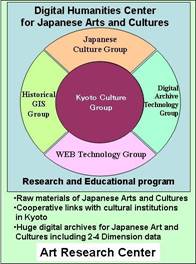- MAIN MENU
- Overview
- Background
- Aims
- Education
- Research
- Intro. Movie
- Access
- Contact
- ACTIVITIES
- Information
- Applications
- Data
- From Office
- GCOE Seminars
- International Symposiums
- DH-JAC2009
- Abstracts
- Profiles
- Time Table
- Publications
- News Letter
- Research Meetings & Events
- Research Members
- Research Projects
Research

We will utilize the digital archives of tangible and intangible cultural properties developed during the 21st Century COE in order to further deepen humanities research, and promote the worldwide cooperative management, and distribution of the archives, based on the ideas of Digital Humanities. Our digital archives will bring together information on Japanese art and culture now scattered all over the world. The archives will use information management technology to combine different types of data: text, pictures, sound, moving images and the motion of the human body.But also by systematically linking to databases on other systems, they will revolutionize the amount and quality of material available for research, leading to great improvements in the quality of research and to a new perspective on humanities studies. GIS technology will lead to further advances in the visibility and amount of data relating to the time and space content of various aspects of culture and the built environment . Using the bi-directional format network environment of Web 2.0, we will create a portal that makes information more open, cooperative and usable. We will focus on the subjects in which cooperation between humanities research and digital archives technology is effective, for example, a system for viewing folding screens, the three-dimensional measurement and analysis of carved woodblocks, the archiving and analysis of materials related to Japanese music and the performing arts, and an analysis of the three-dimensional form of ceramics.The resulting research will be compiled and distributed on-line. We will also promote research into analytical methods and archiving technology related to the exquisite cultural properties that characterize the historic cultural city of Kyoto.

